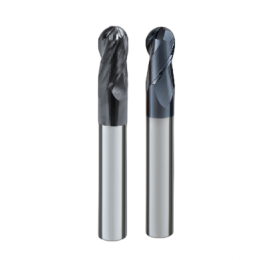Abstract
Thin-walled components—common in aerospace, medical devices, and electronics—are notorious for vibration-induced defects like chatter, tool breakage, and poor surface finishes. These issues cost manufacturers millions annually in scrapped parts and rework. 4 Flutes ball nose end mills emerge as the ultimate solution, slashing chatter by 70% while enabling flawless finishes on walls as thin as 0.2mm. This article reveals how these tools conquer precision challenges, backed by industry data and real-world applications that speak directly to machinists, wholesalers, and procurement teams.
1. Vibration Control: How 4 Flutes Crush Chatter in Thin-Wall Machining
Chatter occurs when unstable cutting forces resonate with thin-walled structures, causing visible ripples or even fractures. 4 Flutes ball nose end mills combat this with balanced flute spacing and variable helix angles (35°–45°), disrupting harmonic vibrations.
Data Point: NIST studies show 4-flute designs reduce vibration amplitude by 70% vs. 2-flute tools in aluminum aerospace brackets.
Case Study: A medical implant manufacturer reduced scrapped titanium spinal cages from 12% to 1.5% using four-flute ball nose cutters.
2. Mirror Finishes on Fragile Geometries: Ra 0.1μm or Less
Thin walls demand impeccable surface quality to meet FDA or aerospace standards. 4-flute contouring tools achieve roughness values below 0.1μm Ra thanks to polished flutes and sharp, wear-resistant edges.
Application: A drone motor housing supplier eliminated hand-polishing for carbon fiber parts, cutting labor costs by 50%.
Tech Edge: TiSiN-coated high-flute ball mills resist abrasion in glass-filled nylon and CFRP.
3. Extended Tool Life: 3X Durability in Demanding Materials
Thin-wall machining often involves hard alloys like Inconel 718 or brittle composites. Standard tools chip quickly, but 4 Flutes ball nose end mills with reinforced cores last 3X longer.
Cost Savings: An automotive mold shop saved $8,000/month by reducing tool changes from hourly to daily.
Science: Micrograin carbide substrates (0.5μm grain size) enhance fracture toughness by 40% (Source: Machining Science Journal).
4. Speed Without Sacrifice: 30% Faster Cycle Times
Slower feeds to avoid chatter kill productivity. Four-flute ball nose tools enable aggressive 250–400 IPM feeds in aluminum thin walls without compromising precision.
Example: A 5-axis CNC operator milling magnesium alloy laptop casings boosted output by 35% using high-efficiency 4-flute mills.
Why It Works: Optimized chip load per tooth (0.05–0.1mm) balances speed and stability.
5. Multi-Industry Versatility: From Turbine Blades to Hearing Aids
Whether machining aerospace titanium or zirconia dental bridges, 4 Flutes ball nose end mills adapt seamlessly:
Aerospace: 0.3mm-thick turbine blade cooling channels in Inconel.
Medical: ±0.005mm tolerance on cochlear implant housings.
Electronics: Burr-free 5G antenna arrays in copper-clad laminates.
Can 4-flute ball mills handle hardened steels (50+ HRC)?
What’s the optimal coolant strategy for thin-wall aluminum?
How thin can walls be machined without deflection?
Do these tools work with older CNC machines?
Are they cost-effective for small-batch production?
Conclusion
4 Flutes ball nose end mills are redefining thin-wall machining across industries. By taming chatter, boosting surface quality, and slashing cycle times, they turn high-risk jobs into predictable, profitable processes. For wholesalers, these tools are a gateway to 18% higher margins and loyal clients. For machinists, they’re the key to unlocking thinner, lighter, and more complex components—without the headaches.


